Determining what is the best grow bag size for vegetables is crucial to cater to each type of vegetable crop according to its needs yet many gardeners are unaware hence in this article we have compiled how to choose the grow bags and their sizes, and our top picks.
Additionally, we will discuss how grow bags can be decorated, the best soil for the bags, and what to do with bags in winter. Without further delay, let’s go ahead!
Contents
Choosing The Best Grow Bags
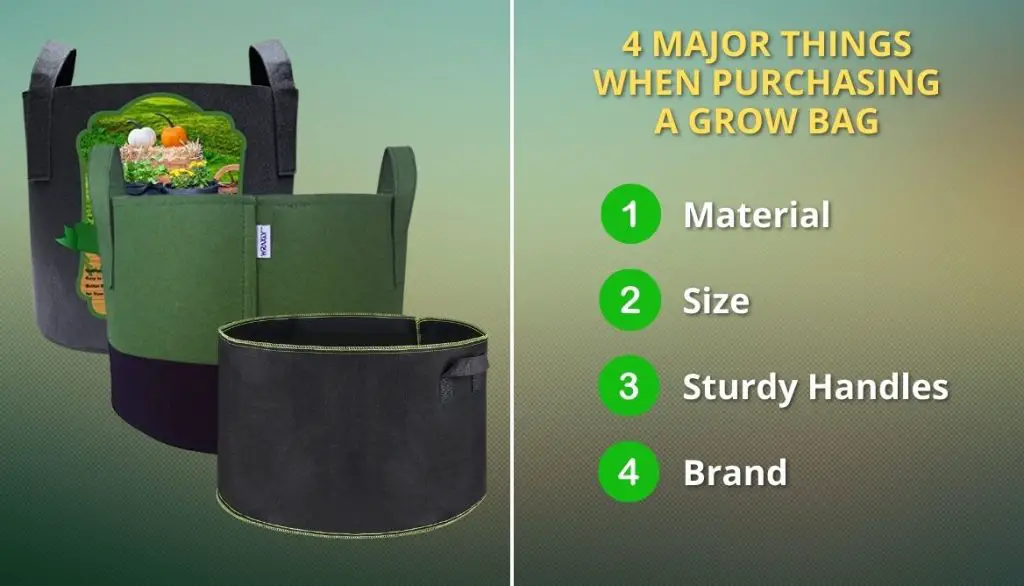
There are four major things to keep in mind when purchasing a grow bag.
1. Material
You should use heavy-duty landscape fabric such as Polypropylene. We recommend this because it is food-grade and harmless. It is also long-lasting.
Polyethylene is also one of the recommended landscape fabrics.
2. Size
The grow bag depth and diameter should be taken into consideration because each species of plant has different space requirements for the roots to spread and for water retention.
Scroll down to read the section “What Size of Grow Bags to Use?” and What Kind of Plants Can Be Grown in a Fabric Grow Bag? to learn about the recommended sizes for various vegetables.
3. Sturdy Handles
Handles are a vital part of the grow bags. You will have to move the bags around or hang them up this is why strong handles are important and a grow bag should have those.
It is better to go for bags that have handles as part of them rather than sewn on top of them as stitched-on handles can detach after some time.
4. Brand
Buy from a trusted brand only. It is better to spend more on a reliable brand than a cheap knock-off that will not provide the desired results.
We recommend Gardzen, VIVOSUN, Wraxly, Root Pouch, and Smart Pots.
Best Grow Bags: Our Top Picks
Name: | Gardzen Grow Bags | Wraxly Fabric Grow Bags | VIVOSUN Reinforced Fabric Pots |
Photo: | |||
Dimensions: | 16"Dx16"Wx12"H | 8.66"Dx13"Wx6.69"H | 19.9"Dx19.9"Wx11.9"H |
Materials: | Non-woven fabric | 2mm Non-woven fabric | 300g Non-woven fabric |
Shape: | Round | Cylindrical | Round |
Mounting type: | Floor Standing | Floor Standing | Free Standing |
Other features: | Drainage Holes, 100% avoid transplant shock | Drainage Hole, Aeration zone | Tear-proof, Double- stitched |
Rating: | |||
Available: |
1. Gardzen 10-Pack 5 Gallon Grow Bags
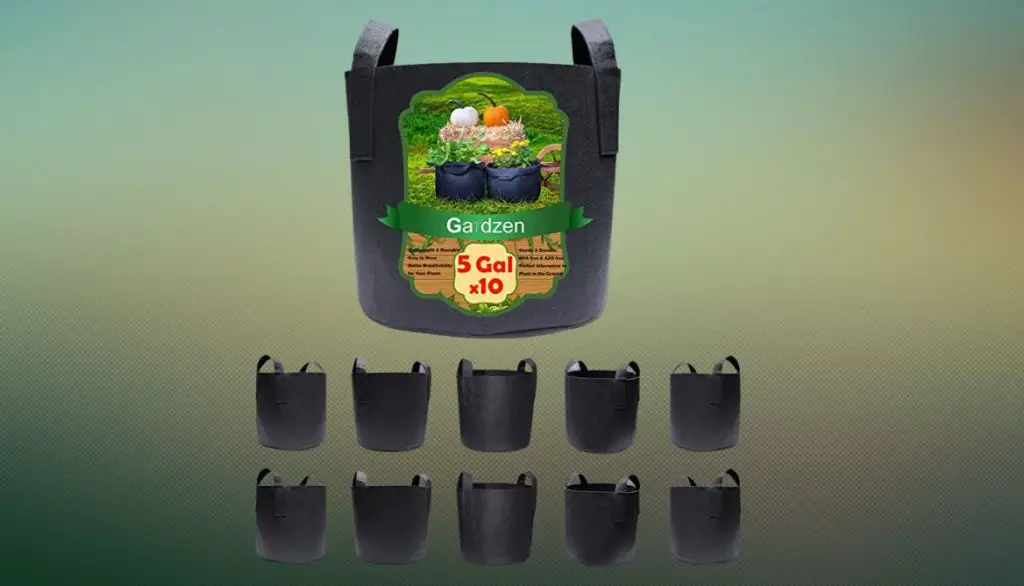
Material: | High-end non-woven fabric. BPA-free and AZO-free |
Dimensions: | 16"D x 16"W x 12"H |
Shape: | Round |
Mounting type: | Floor Standing |
Double-stitched Handles: | Yes |
Other features: | Drainage Holes, 100% avoid transplant shock, Environment Friendly |
Gardzen’s made our list due to the healthy root growth environment these grow bags provide. Their grow bags are lightweight, reusable, and available in various sizes. The material used is breathable fabric and optimal for growing plants.
- Fabric is long-lasting due to the high-end material.
- The material is health-wise safer to use (BPA-free and AZO-free).
- Can be reused and recycled.
- Handles won’t tear off easily.
- Available in only one color.
2. Wraxly Fabric Grow Bags – 7 Gallon
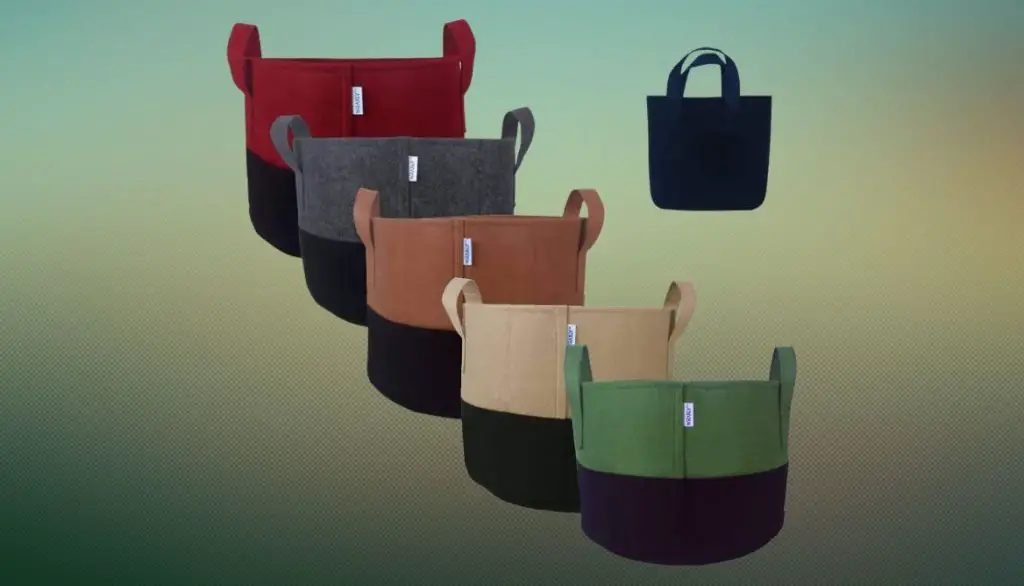
Material: | 2mm Non-woven fabric |
Dimensions: | 8.66"D x 13"W x 6.69"H |
Shape: | Cylindrical |
Mounting type: | Floor Standing |
Color Variant: | Vivid and rich two-tone color |
Lining: | Extra lining on the inside |
Other features: | Drainage Hole, Aeration zone, Waterproof lining |
Wraxly has created a roar in the market and all the credit goes to their two-tone grow bags.
These grow bags are known for being the best of both worlds as they do not compromise on functionality but also look more attractive than usual monotone blacks.
- Minerals remain intact in the grow bag.
- The grow bag does not stain over time due to the waterproof lining.
- The two-tone colors of these grow bags beautify your gardens.
- Wraxly offers to return the product if unsatisfied.
- Will need frequent hand-washing to keep it clean.
3. VIVOSUN 10-Pack 15 Gallon Grow Bags
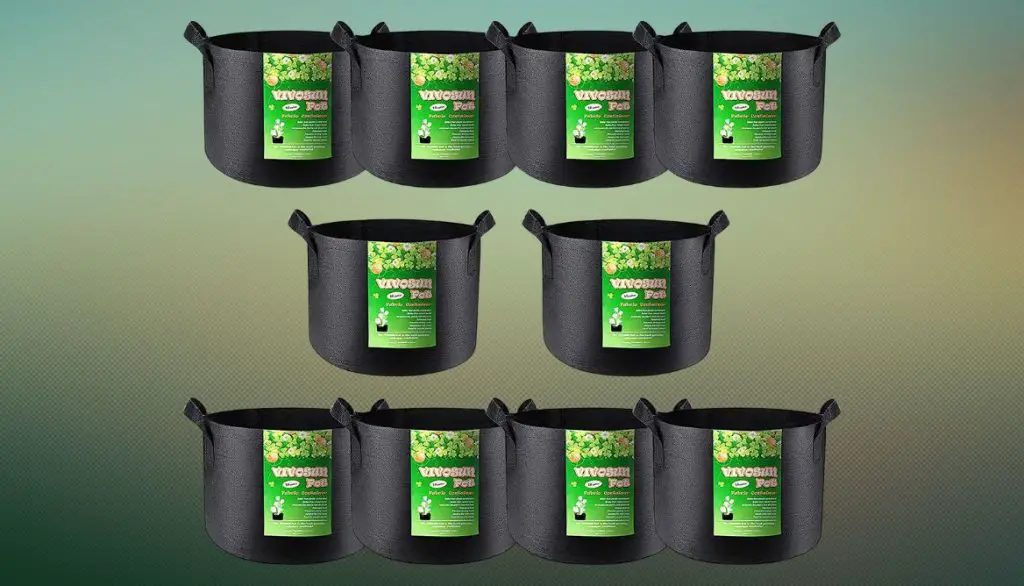
Material: | 300g Thickened nonwoven fabric, Non-toxic Polyethylene |
Dimensions: | 19.9"D x 19.9"W x 11.9"H |
Shape: | Round |
Mounting type: | Free Standing |
Other features: | Durable, Reinforced Handles. Tear-resistant |
VIVOSUN Grow bags are famous in the market due to the 300g thick fabric. Its competitors have thinner grow bags risking water leakage and poor air pruning.
The material is BPA-free and provides a perfect light blockage.
- The grow back does not allow circling root structure.
- A drainage hole gets the excess water out.
- Durable Handles.
- Can be pricier so buying on sale is better.
4. SunArea 10-Pack 10 Gallon Grow Bags
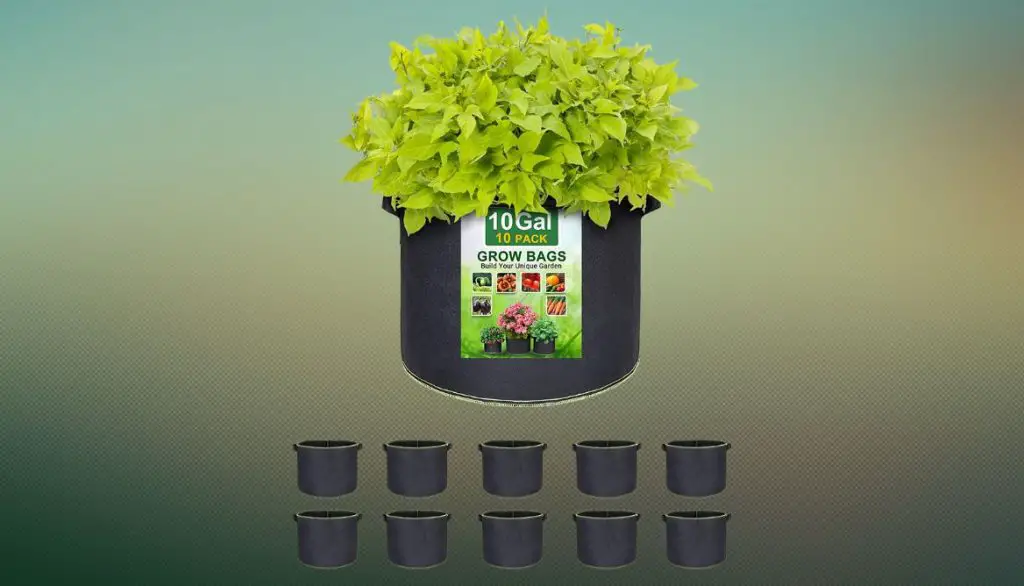
Material: | 300g thickened non-woven, Biodegradable |
Dimensions: | 15.7"D x 15.7"W x 11.8"H |
Shape: | Round |
Mounting type: | Plant Stand |
Other features: | Optimized for moist soil, Drainage Holes, Sturdy handle |
SunArea is one of the top producers of fabric grow bags. Their bags have breathable fabric that helps keeps the soil moisture maintained for healthy roots.
SunArea grow bags are available in various sizes so you can build a whole vegetable garden using these.
- Keeps a balance between drier soil and moist soil.
- Air circulation for roots to breathe.
- Ample space for planting all vegetable crops.
- Can last long.
- Potting soil must be filled to the top or else it can bend.
5. VIVOSUN 5-Pack 20 Gallon Plant Grow Bags
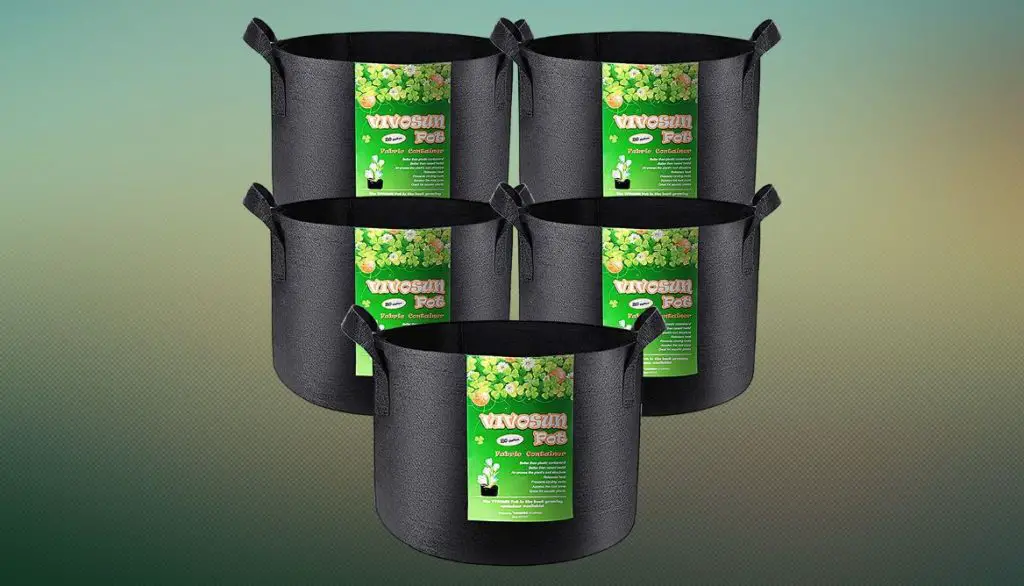
Material: | 300g Nonwoven Fabric |
Dimensions: | 19.9"D x 19.9"W x 15.9"H |
Shape: | Cylindrical |
Mounting type: | Floor Standing |
Other features: | The self-adhesive seam on the sides, Reinforced Handles, BPA-free, and Reutilization |
Vivosun specializes in fabric grow bags that are able to conserve nutrients and let air pruning happen naturally making a nourishing environment for root vegetables.
The 300g fabric with X-stitching on handle-ends makes these high-quality grow bags.
- Easy transplantation.
- Drains excess moisture.
- Can last for 3 years if maintained properly.
- This product is verified by the ‘Transparency Program’ for authenticity.
- Need shielding from constant direct sun to avoid UV weakening.
6. JERIA 12-Pack 5 Gallon, Vegetable/Flower/Plant Grow Bags
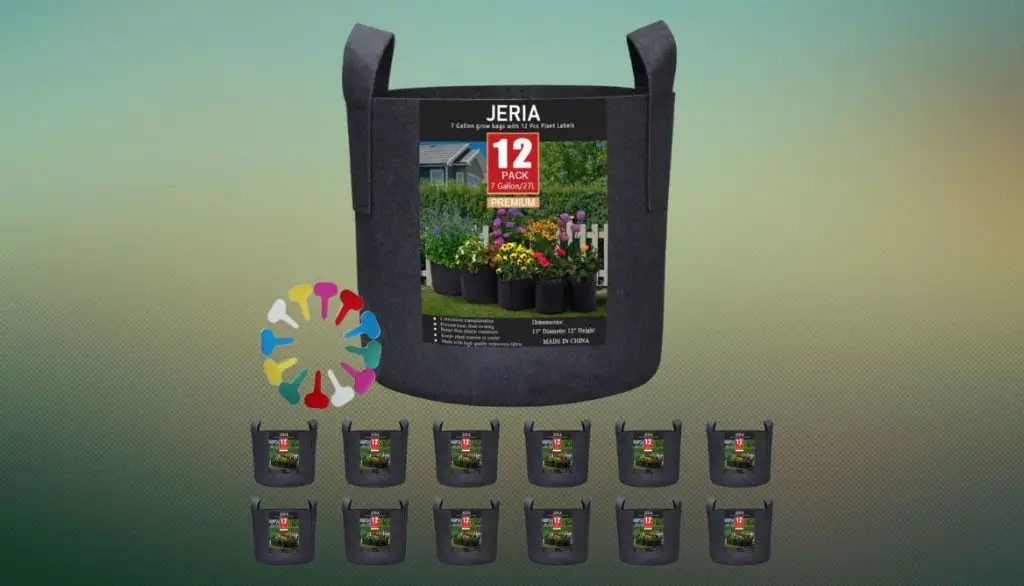
Material: | Thickened material designed to promote the absorption of nutrients |
Dimensions: | 12"D x 12"W x 10"H |
Shape: | Round |
Mounting type: | Free Standing |
Other features: | Small-size grow bag, Reinforced handles |
Jeria’s fabric grow bags are a perfect solution for the growing season as one can plant both vegetables and fruits. Customers have grown pineapples, tomato plants, onions, bell peppers, eggplants, and sweet potatoes in them.
The permeable fabric allows for healthier root systems and the correct amount of air circulation.
- Roots are properly aerated.
- Multiple sizes of grow bags are available for all kinds of vegetables.
- Create a container garden in less space.
- Easily move and portable.
- Can be difficult to soak plants as drainage seeps out all excess water.
Benefits Of Grow Bags
Fabric grow bags have endless benefits and has been part of the gardening revolution. We have listed a few so that you can reap the usefulness of grow bags too.
- Grow bags are lightweight so they are ideal for small spaces such as balconies, and roofs.
- They make beautiful vertical gardens.
- These have dual handles, doubly stitched so if needed to be moved you can count on fabric grow bags.
- Unlike plastic containers, grow bags have air circulation resulting in healthier roots.
- The grow bags encourage air pruning so new and young fibrous roots grow.
- New healthy roots help with the top growth of the plants and one is able to harvest a high-quality crop.
- It drains excess water on its own.
What Kind Of Plants Can Be Grown In A Fabric Grow Bag?
If you are able to grow plants in a pot then growing in grow bag is definitely possible. Grow bag gardening can help you grow tomatoes, lemons, and herbs among many other vegetables.
Have a look at the vegetables you can grow, and how much water, sunlight, and container depth they require to come to fruition.
PHOTO | VEGETABLE | GROW BAG DEPTH | GROW BAG WIDTH | SUNLIGHT | WATERING |
HERBS | 3 to 12 inches | 6 to 20 inches | 6 to 8 hours | Minimal | |
CUCUMBERS | 12 inches | 8 inches | 8 hours | Moderate | |
LEMON | 12 to 15 inches | 28 inches | 12 hours | Moderate | |
SQUASH | 12 inches | 24 inches | 8 hours to 10 hours | Moderate | |
ZUCCHINI | 12 inches | 24 inches | 8 hours to 10 hours | Moderate | |
TOMATOES | 10 inches | 18 to 24 inches | 8 hours | 1-2 times weekly | |
POTATOES | 12 inches | 16 to 24 inches | 8 hours to 10 hours | 1-2 times weekly | |
STRAWBERRIES | 8 inches | 10 to 12 inches | 6 hours to 8 hours | Frequent watering | |
BLUEBERRIES | 24 inches | 24 inches to 30 inches | 6 hours to 8 hours | More Frequent watering |
Decorating Around Grow Bags
All the green thumbs and gardening enthusiasts are not just looking to grow a few plants but also want to make a prettier grow bag gardening place.
If you are looking to upgrade the aesthetics of your gardens we have you covered. Here is what you can do.
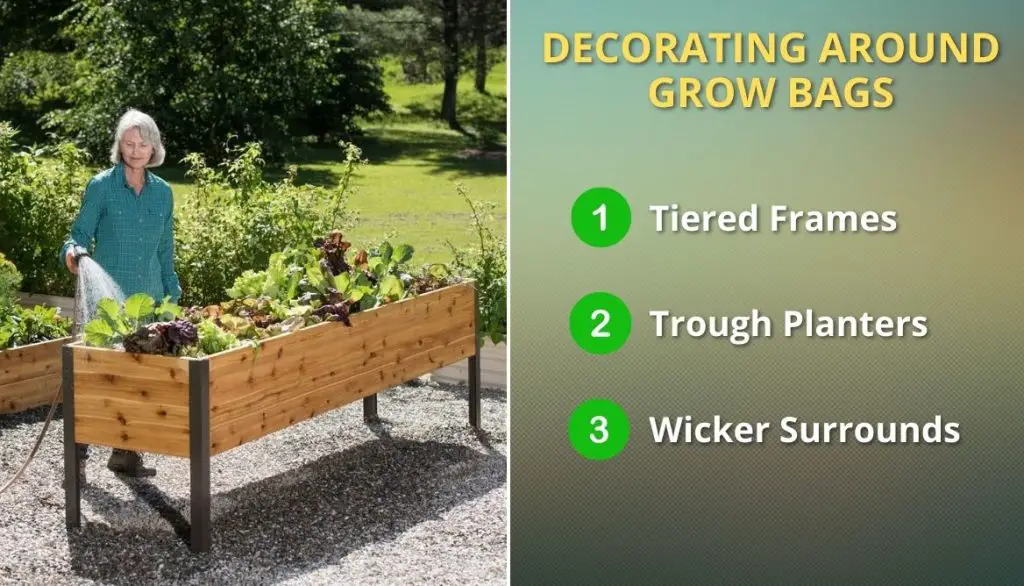
1. Tiered Frames
Stacked grow bags make eye-pleasing vertical gardens. Arranging these on tiered frames and shelves not only makes the grow bag setting attractive but also saves space.
You can place multiple grow bags on the tiered frames as these can be as small as 27 inches.
Tiered frames can be custom-made as per your desire, can be decorated with lights and you can place other garden decorations on them.
2. Trough Planters
Trough planters add sophistication and sleekness to your garden. You can easily place your grow bags in and make fences with your plants.
Trough Planters are available in such a vast variety that you will be able to find the style that is according to your taste.
These have variants with handles as well as without.
3. Wicker Surrounds
Wicker surrounds add earthy tones and a natural jute-like texture around the grow bags. These also give a boundary around the grow bags so you can easily arrange them in between.
These are used on patios, and many use these indoors to add to a home’s interior designs.
How To Use Grow Bags
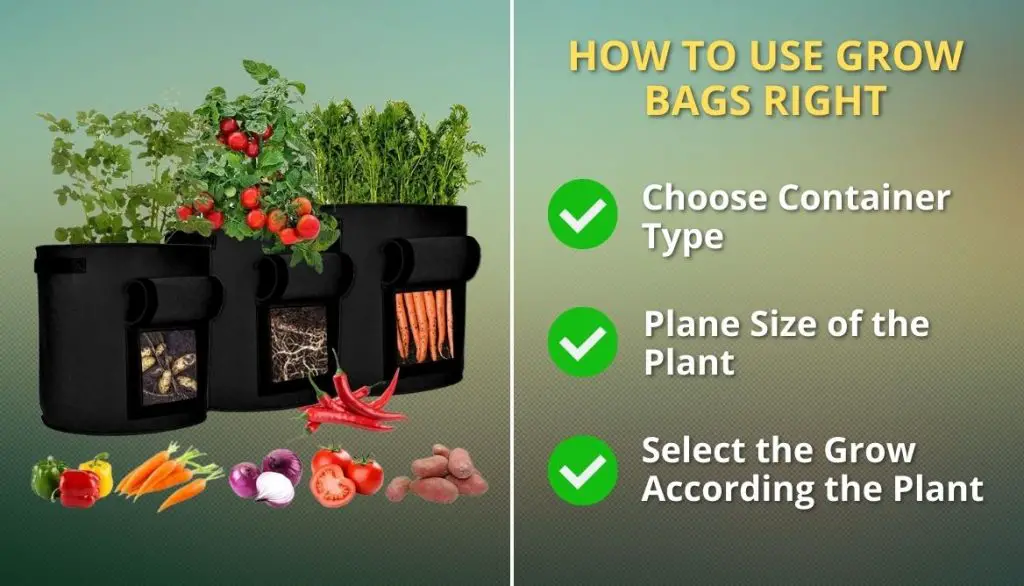
We are now aware that grow bag gardening has numerous benefits, look pleasant to the eyes when plants fully grow and can be embellished with decorative things.
So we should also discuss what to keep in mind when using a grow bag and how to correctly use them.
1. Type Of Container
You should select the type you are going to use. There are two types, fabric grow bags and plastic container grow bags.
Fabric grows bags have better drainage and the material is breathable so aeration is healthful for root mass. Meanwhile needs less watering as opposed to fabric ones.
2. Size Of The Plant
You should plan how huge you want your plant. If you would like it to turn into a tree the grow bag should at least have a 50-gallon capacity.
If you want a plant that spreads to 8 inches and grows 9 inches tall you will need a gallon-to-grow bag.
3. Species Of The Plant
Select the grow bags’ sizes according to the need of the species of the plant.
Herbs require 3 to 12 inches in depth and 6 to 20 inches in diameter to grow best while blueberries need 24 inches in depth and 24 to 30 inches in diameter hence the container size can vastly differ if the species is switched.
The Best Soil Mix To Use With Grow Bags
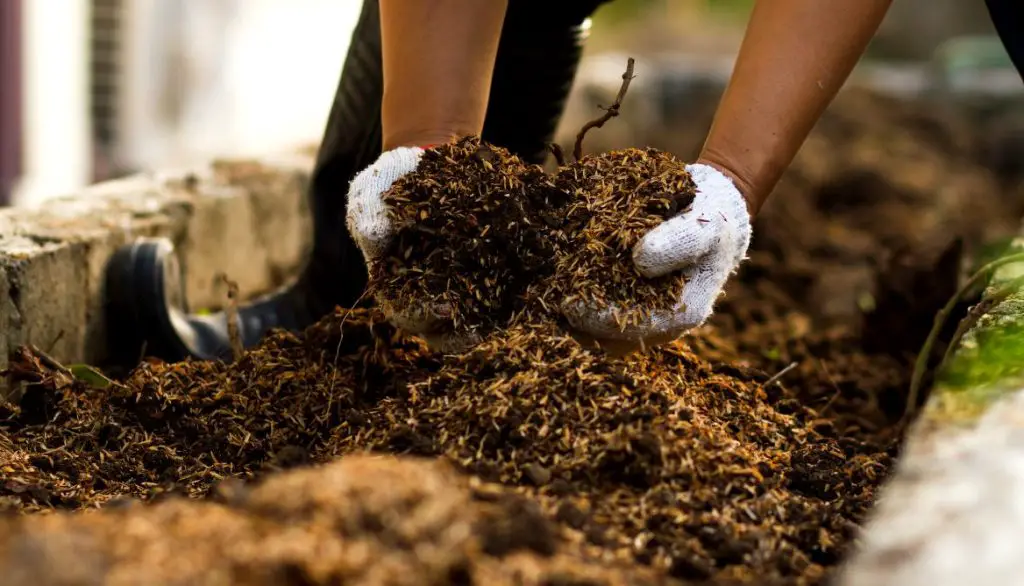
- Here is how you can prepare the best soil mix:
- Make a compost mixture of mushrooms.
- Mix 1/3 of it with 1/3 of moss while filling the rest with vermiculite to help with retaining water.
- Fill the bag up but leave 2 inches of space on the top.
- Lift the bag up by the handles and gently shake it to settle the soil in the bag.
- Check if the grow bag has drainage holes in it. If not use scissors to few small holes enough to get only the excess water out.
- This is it! You will create the best soil mix for your plants.
The Pros And Cons Of Using Grow Bags
It can be argued that while grow bags have a huge list of benefits, it does have flaws of it own so we are putting the pros and cons of the grow bags parallel for your awareness.
- Grow bags are portable.
- Plastic containers can crack under severe weather but grow bags can withstand it
- The bags promise to last at least 3 growing seasons.
- With grow bag gardening you can move your plants with you.
- Aeration and draining in grow bags make a robust root system.
- Grow bag is unable to save the plant from gophers.
- Grow bag quality can be low if the brand is not known.
What Is The Best Grow Bag Size For Vegetables?
To put it simply, the grow bags that plant small rooted plants are less than 50 gallons. Anything above 50 gallons turns into a tree.
We have classified vegetables and recommended bag size for them.
Grow Bag | Description |
1-gallon Grow Bag | A 1-gallon grow bag is good enough for baby tomatoes while a 4-gallon is for our average-sized ones |
3-gallon Grow Bag | A 3-gallon grow bag is best used for salad greens such as lettuce, and spinach, as well as for Basil, parsley, and rosemary |
5-gallon Grow Bag | Use a 5-gallon grow bag for plants that grow peppers, cucumbers, and eggplant |
7-gallon Grow Bag | Take a 7-gallon bag for growing tomatoes, potatoes, and onions that are bigger than average use |
10-gallon Grow Bag | A 10-gallon grow bag is used for lemon trees, indeterminate tomatoes, and melons |
Why Use Grow Bags For Gardening?
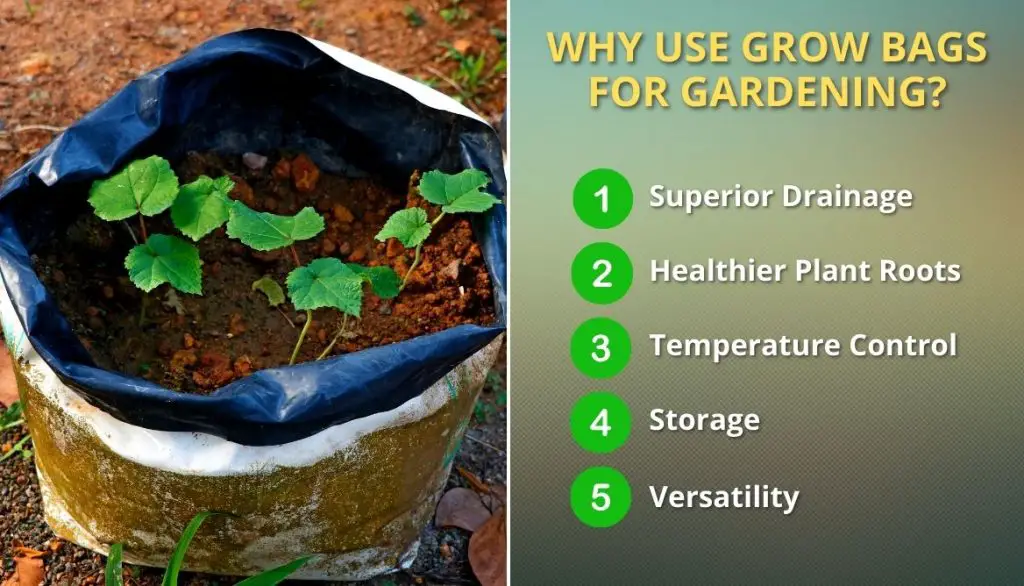
Grow bags are becoming part of many people’s gardens due to their portability, ease of use, and environmental friendliness but the major reasons for being gardeners’ favorites are the following:
1. Superior Drainage
Grow bag has drain holes at the bottom which sweep out all the extra moisture so the roots do not rot.
It leaves behind enough water that the plant requires making it’s drainage superior and efficient.
2. Healthier Plant Roots
Root systems in grow bags grow happily because in other planters roots hit the bottom and curl up. The root continuously grows aimlessly restricting.
Grow bag roots reach the bag walls and sense air-exposed soil. This indicates soil that needs to stop growing. Shorter roots help transport nutrients faster to the leaves.
3. Temperature Control
Grow bag is able to maintain optimal temperature for plants as it is made of fabric that allows air to flow inside.
This keeps the roots cool preventing it from burning off.
4. Storage
Grow bags can be easily emptied, washed, and folded for storage. It consists of handles so it can be carried and transported.
5. Versatility
Grow bags are available in various sizes and one can find sizes that perfectly cater to certain plants’ growth space requirements.
These can be stacked on top of each other, placed on tier frames, hung on the walls and even be in grounded.
With grow bags, you can have the garden of your desire.
What To Do With Grow Bags In Winter
If you are wondering what to do with the grow bags once the growing season is past we and winter are approaching we have a guide for you.
- You can take the potting soil mix out of your grow bags, wash the grow bags, dry them, and have them stored properly until the spring.
- If it is inconvenient for you and you can leave potato and carrot plants out in the winter. These are unharmed in the cold in fact these will be nicely stored.
- Although most plants find it hard to survive the harsh weather and it is better to either ground them or put them on a raised bed.
How To Clean Fabric Grow Bags
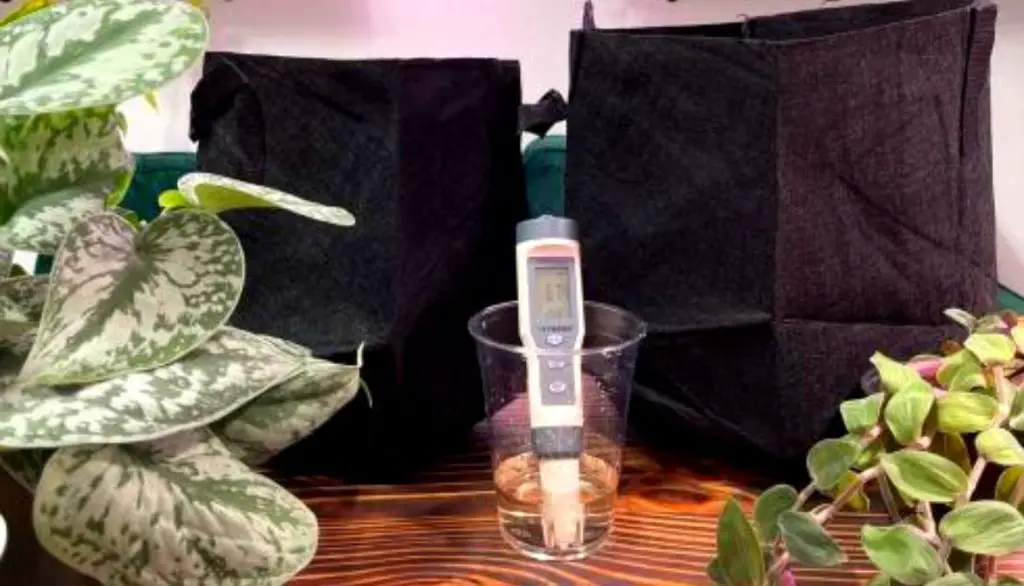
Cleaning grow bags is the same as cleaning any other fabric. You can follow along:
- You empty the soil content, shake any root that is sticking out and clear the bag.
- Then wash the bag with a hose. It is advised to not use a washing machine as it might damage the delicate drainage and specialized fabric.
- If you need to thoroughly wash it, then at this step you can use baking soda and detergent.
- Let it soak in the tub then rinse the soapy water off.
- You can then let it dry in the air and finish the job.
FAQ
What Size Grow Bags Do I Need For Vegetables?
The grow bags that plant small rooted plants are less than 50 gallons. The bags that have a capacity of 50 gallons are for trees.
How Big Is A Standard Grow Bag?
A standard grow bag can be 14in x 37in that can plant 3 vegetables.
How Do I Choose A Grow Bag?
Choose a good brand of grow bag. Make sure it is made with thick fabric and has drain holes.
Does The Color Of Grow Bag Matter?
Soil sweeps out and stains the grow bag which is why most are black colored but Wraxly Fabric has introduced a two-tone bag that does not let the soil leave a stain.
Which Type Of Grow Bag Is Best?
Fabric grow bags are considered better than plastic pots and bags as aeration and drainage are better in those.
What Makes A Good Grow Bag?
A good grow bag should have sturdy, double-stitched handles, breathable fabric, drain holes, and a size tag sewed.
Conclusion
There we have it! Everything to know about grow bags from the correct size to the best product in the market and how to use them.
We hope this guide has been useful to you. Share with us what are you planning to grow in the bags. Do your homegrown vegetables thrive in the grow bags?
- How to Get Potatoes to Sprout Eyes: Detailed Growing Guide with 3 Options - July 31, 2023
- Weight of a Medium Potato: Revealed in Detailed Guide - July 29, 2023
- Maris Piper Potatoes: 9 Substitutes You Should Know About - July 27, 2023
Hello! I’m Jessica Zander, a garden coach and consultant based in the Boston area (zone 6b), offering virtual consultations across the country and Canada.
I’ve been passionate about gardening since the early 1990s, and in 2022, I launched You Can Do It Gardening to empower individuals to feel more confident in their gardening endeavors.
Following a 30-year career in nonprofit finance and operations, I transitioned out of that field in mid-June of 2023 due to the growing demand for coaching services. Interestingly, my years of presenting financial statements to boards and finance committees proved to be valuable experience for teaching people about gardening! I enjoy sharing skills, providing guidance and suggestions, and collaborating efficiently with clients to make significant improvements to their outdoor spaces, both small and large. I also regularly teach at the Arlington Continuing Education and Cambridge Adult Education.
My approach is direct and practical, akin to Mary Poppins, but tailored to your garden. Clients find satisfaction in saving money and taking pride in their own gardening achievements.

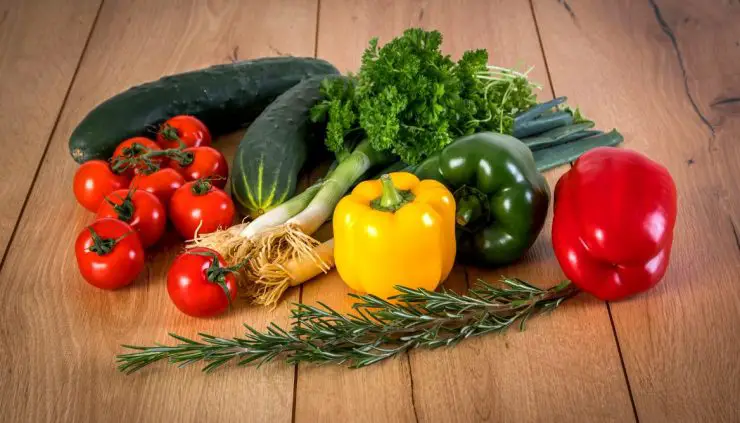













Add comment